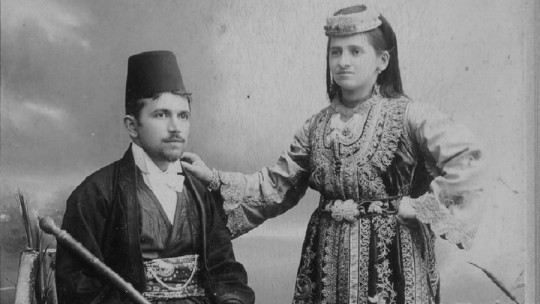Castile and Aragon had very large Jewish communities, until in 1492, under the reign of the Catholic Monarchs, a violent religious cleansing was carried out, expelling all those who believed in Yahweh.
These Jews wandered through various countries in Europe, Africa and Asia, without forgetting where they came from, preserving medieval Spanish as a vehicle of communication and longing for the Iberian Peninsula, their Sepharad.
These are the Sephardim, a Hebrew people who continue to exist today, with an extensive diaspora around the world and which we are going to talk about next, looking at its history, language and culture.
Who are the Sephardim?
The Sephardim, also called Sephardim, Sephardim or Sepharadites (from the Hebrew ספרדים, “Sepharaddim”, literally ‘the Jews of Sepharad’) They are the descendants of the Jews who lived in the Crown of Castile and the Crown of Aragon until their expulsion in 1492 by the Catholic Monarchs The word “Sephardic” comes from “Sepharad”, a biblical term with which the Hebrews referred to the Iberian Peninsula.
Although today the Sephardim live in many countries, especially France, Argentina, the United States, Canada and, above all, in Israel, they do not forget their Spanish past, having requested to receive Spanish nationality as compensation for the centuries of religious persecution experienced. . This Sephardic diaspora has at least two million members, and can be found, in addition to the countries mentioned, in many Latin American countries, North Africa and Turkey.
When they lived in the Iberian Peninsula This town developed important and prosperous communities in most of the cities of the Crown of Castile , highlighting communities such as Ávila, Burgos, León, Segovia, Soria, Tudela, Toledo, Vitoria, Córdoba, Granada, Jaén, Málaga and Calahorra. There were also in the Crown of Aragon, with communities or “calls” found in cities such as Girona, Barcelona, Tarragona, Palma, Valencia and Zaragoza, and in Portugal, in cities such as Lisbon, Évora and Beja and an important community in the region of Trás-os-Montes.
History of this group of Jews
Although we cannot consider them Sephardic, There is evidence of a Jewish presence in the Iberian Peninsula and the Balearic Islands in Classical Antiquity , given that archaeological remains of Semitic trousseau have been found in Ibiza and various corners of Iberia. Although these could be remains imported by the Punics, they could be from a very primitive Hebrew community in Spain.
Visigoths and Al-Andalus
The Jewish community, not yet Sephardic itself, increased over the centuries. After the fall of Rome and the creation of Christian kingdoms throughout Europe, the Visigoth kingdom was founded in Iberia, which ended up adopting Catholicism as a faith during the reign of Reccaredo (587 AD). It is at this time that the first great persecution, isolation and rejection of the Hebrews in the peninsula occurred, who had formed the first Jewish quarters and aljamas in Spanish territory.
Given the difficult conditions in which the Jews found themselves during the Visigothic kingdom of Toledo, When this state collapsed before the Muslim invasion, the Hebrews saw the new rulers as a liberating force Jews and Muslims had good relations at the time, since their two religions were considered deserving of the same conditions when treating each other as they had books, the Talmud and the Koran, respectively, as the basis of their doctrines.
Starting in the year 711, Jewish quarters increased throughout the peninsula The victory of the Muslim conqueror Táriq ibn Ziyad translates into an improvement in the living conditions of the Jews, as there is a better environment for coexistence in the Iberian Peninsula. Muslims tolerate the presence of these people, as long as they pay the dhimmi, a tax imposed on Jews and Christians so that they could continue living in Muslim territories.
During the centuries of Andalusian splendor the Iberian Hebrew community was the largest, organized and culturally advanced. Many Jews from other parts of Europe and Arab territories moved to Al-Andalus, integrating into the existing community and greatly enriching it. These Jews They learned the Arabic language and held government positions or engaged in commercial and financial activities
One of the reasons why they were so well received and adapted so well in Muslim territories was the fact that they dedicated themselves to professions that handled economic aspects. In Islam it was forbidden to engage in financial activities, while among Christians these were considered impious. Thus, the Jews, who had no qualms about dedicating themselves to them, occupied this sector as treasurers, tax collectors, moneylenders and money changers, eventually amassing fortunes.
Despite the relative tolerance of the Islamic culture of the time, the Jews were not spared from various ethnic cleansings , perpetrated by both the muladi population and the Arab rulers. Several were made during the Almoravid domination and, above all, during the Almohad. Among the great massacres, the Granada Massacre of 1066 stands out. This caused the flight of numerous Jewish families towards newly conquered Christian territories, mainly to the Kingdom of Toledo.
The expulsion of the Jews
In 1492 the Catholic Monarchs enacted the expulsion of the Jews in the crowns of Castile and Aragon The exiles settled in nearby Navarra, still semi-independent, and Portugal.
However, this tendency to carry out a religious cleansing spread to the rest of the Iberian kingdoms, causing the Sephardim to have to go to North Africa and the Italian States. An important community moved to northern Europe, going to England and Flanders
However, those who had the best luck were those who settled in Ottoman lands, such as the Middle East, North Africa and the Balkans.Sultan Bayezid II gave orders that the Sephardim be treated well This Ottoman leader exclaimed that the Jews were a great source of cultural and economic wealth, and that he could not understand how Ferdinand II of Aragon could be considered a good king while making his kingdoms poorer countries.
It is really at this time that Iberian Jews began to be known as Sephardim, because in their exile they saw Spain as their motherland, the one they longed for and wanted to return to. As in the Bible the Sepharad is originally understood as a distant land, the Jews began to use this word to refer to Spain They preserved many traditions typical of the Iberian Peninsula, used medieval Spanish as a vehicle of communication and remembered their cities of birth.
The Sephardim in the Ottoman Empire
In the Ottoman Empire, the Sephardim formed four very large communities, larger than those that had been formed in Spain : Thessaloniki, Istanbul, Izmir and Safed. Even so, there was a significant population in all the important cities of the Empire, founding communities in Sarajevo, Belgrade, Sofia, Bucharest, Alexandria, Tekirdağ and Bursa.
They very rarely mixed with the native population, since they had a higher cultural level than the inhabitants of their new cities of residence. This meant that they kept their culture, traditions and languages practically intact, with very few influences from local cultures. For almost five centuries they continued to speak Judeo-Spanish. This trend was not followed by the Sephardim who went to Holland and England.
His financial skills allowed many to achieve high standards of living and even retain a privileged status in the Ottoman courts Some of the wealthiest Sephardic families in Istanbul financed the campaigns of the Ottoman army, and many of the members of that city’s Jewry gained privileged positions as high-ranking officers.
There are hundreds of Jewish neighborhoods built by the Sephardim during their stay in the Ottoman Empire. Only in the city of Thessaloniki, present-day Greece, they built all kinds of communities and synagogues which they baptized with names that reminded them of their life in the Crowns of Castile and Aragon and in the Kingdom of Portugal: Kal de Kastiya, Kal Aragon, Otranto, Palma, Siçilia, Kasseres, Kuriat, Albukerk, Evora and Kal.
20th century: World wars and Holocaust
Some 400 years have passed since the Jews were expelled from the Iberian Peninsula, the main country of reception of this people, The Ottoman Empire begins to collapse to make way for national states like Greece When the empire was defeated in the First World War, Greece achieved independence and recovered territories historically attributed to the Hellenic country.
The Greek nationalist movement, like any other, had marked overtones of ethnic purity. This ideology ended up developing a strong anti-Semitic movement in the city of Thessaloniki, seeing the Sephardim as contaminators of the civilized and prestigious Greek identity. Thus, the Sephardim relived the traumatic memory of seeing how the land in which they lived became a land hostile to their identity.
So these Sephardim They fled to France, due to the French influence that the Universal Israelite Alliance exerted on the educated Sephardim, while others went to the United States Many of these Jews did not have any nationality, since at the time of birth they were registered as citizens of the Ottoman Empire, a state that ceased to exist in 1923. In some cases Greece granted passports and guarantees to the Sephardim as citizens of the kingdom, even if they were not very linked to their new “homeland”.
In Istanbul and Izmir, the Jewish quarters did not undergo major changes because when the Ottoman Empire passed to the Republic of Turkey, all citizens, whether Muslims, Christians or Jews, were protected Turkish citizens. The State became secularized, annulling the dhimmi tax on non-Muslim subjects that the caliphate had imposed in previous centuries. The Jews were safe for almost the entire 20th century and it was only when the State of Israel was founded that it began to gradually disintegrate
With the arrival of the Second World War, the Sephardic community suffered a dramatic decline. The Holocaust falls on the Jews; The extermination policies implemented by Nazi Germany and its occupied countries make Sephardic culture almost disappear Many died, and those who were able to flee ended up mostly in Latin America, especially Argentina, Brazil, Venezuela, Mexico, Paraguay or Chile.
After the end of the conflict and the State of Israel having been founded, the Sephardim did not lose hope. The creation of this country involved the founding of a state in which being Jewish was not a crime, in which Hebrew could be spoken freely, and which could be considered home. For this reason, a large group of Sephardim ended up in this state, seeing that, although it was not Spain, it was at least a safe place. The creation of this state was not without controversy, since giving those lands to the Jews meant taking them away from those who already lived there, the Palestinians.
The Sephardim today
Currently, the Sephardic community resides mostly in the State of Israel, with a notable presence in Tel Aviv, Haifa and Jerusalem They have their own representation in the Knesset (Israeli parliament) and even a rabbi who acts as a leader among the Sephardim, Yitzhak Yosef (since 2013). The Sephardic religious party Shas is one of the main political forces in the State of Israel.
Relations between Spain and the Sephardic community have been strengthening, in an attempt to amend the persecutions they experienced during the 15th century. Since 1982, Spain has established the recognition of nationality for Sephardim, as long as they demonstrate that they have a clear connection with the country.
Sephardic, Ashkenazi and Mizrahim
During the 19th century the term “Sephardic” was used to designate any Jew who was not of Ashkenazi origin (of German, Central European or Russian origin). Thus, this classification included not only Jews descended from those of the Iberian Peninsula, but also those of Arab origin, from Persia, Georgia, Armenia, Yemen and even India.
These non-Iberian Jews had little in common with authentic Sephardim, beyond pronouncing Hebrew in a similar way and having some very different rites from those of Ashkenazi Jews.
However, once the State of Israel was founded, it was decided to create a new classification to refer to Jews who did not come from the Iberian Peninsula or Central and Slavic Europe, calling them “mizrahim” In this way, the term “Sephardic” referred only to the human group formerly linked to the Iberian Peninsula, with a mostly Judeo-Spanish language and with racial traits typical of Mediterranean Europe.
The Judeo-Spanish
The language of the Sephardim is Judeo-Spanish, also called Ladino or Djudezmo (his autoglottonym ג’ודיאו-איספאניול transcribed as “djudeo-espanyol”). This speech is a mix between medieval Spanish, which the Jews spoke when they were expelled from Spain, and terms from Hebrew, although there is also a wide vocabulary from other languages: Arabic, Turkish, Greek, Italian and the French. This is because, after their expulsion, the Sephardim ended up in many countries and became imbued with their cultures.
Although it is recognized as a language apart from Spanish, this classification is somewhat controversial. In essence, it is medieval Castilian written more or less phonetically, and both the Latin alphabet and the alphabet, that is, the alphabet of the Hebrew language, and the Cyrillic (Slavic alphabet) can be used to represent it. There are those who consider it a dialect of modern Spanish and, in fact, the Royal Academy of the Spanish Language has a section dedicated to its study and promotion.
Currently this language contains a fairly small community, something that is not surprising taking into account what the history of Jews in general and Sephardim in particular has been during the 20th century. Although there have been publications written in this language for several decades, both in Latin and Alphabet, The body that regulates it, the Academia Nasionala del Ladino in Israel, has only been in existence for two years, having been founded in 2018
Although a large number of Judeo-Spanish speakers were lost during the Holocaust, some continue to survive today, striving to ensure that this language is not lost. The Sephardic diaspora, both in Israel and in the rest of the world, promotes scientific and cultural activities in this language. There are publications in this language such as “Aki Yerushalayim” completely printed in Judeo-Spanish, which contains articles of interest to the Sephardic community. In Spain there is a magazine with a similar tendency, “Sefarad”, published by the Benito Arias Montano Institute.
Next we will see a few examples of this language, Judeo-Spanish









